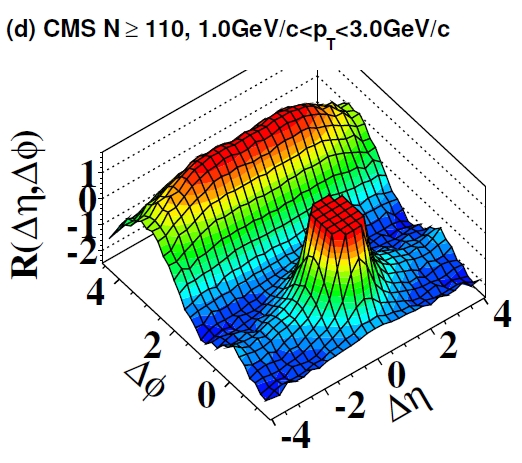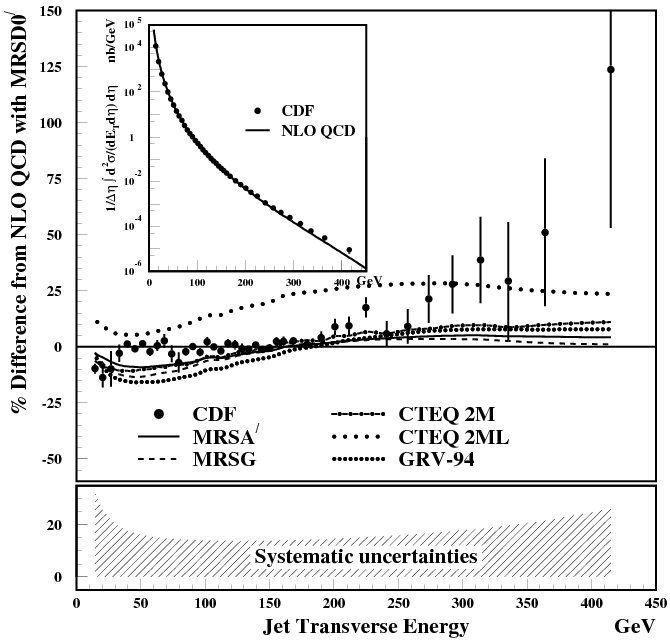The Analysis In Ten Lines
In a nutshell, CMS is observing that in proton-proton collisions yielding a large number of final state particles, there is a long-range correlation between particles emitted at very different angles with respect to the proton beams, but at the same value of azimuthal angle. The effect can be observed in the figure below.

The figure shows the correlation between the polar angle and the azimuthal angle difference of charged particle pairs observed in the detector. The big peak at (0,0) is a result of the jet structure of proton-proton interactions: quarks strongly accelerated by the collision in the transverse direction fragment into streams of collimated particles. The other striking feature of the distribution is the other big, broader peaked structure, which occur opposite in azimuth with respect to the central peak (that is, at
 ). This can be easily understood as the correlation between particles belonging to two different jets recoiling one against the other. But there is a third nagging feature in the distribution: a small "ridge" for
). This can be easily understood as the correlation between particles belonging to two different jets recoiling one against the other. But there is a third nagging feature in the distribution: a small "ridge" for  , which was not expected in simulations, and which is not there in lower-multiplicity interactions.
, which was not expected in simulations, and which is not there in lower-multiplicity interactions.About the ridge, the CMS publication reads:
"This is a novel feature of the data which has never been seen in two-particle correlation functions in pp or ppbar collisions. Simulation using MC models do not predict such an effect."
The press, as I mentioned above, has made a lot of noise about this new interesting find. In a way this is right: the whole world is looking at the CERN experiments in search for the first signs of new physics, and the tension is high. While the competing GTevatron experiments silently collect huge heaps of data and produce star results, albeit with lower-energy interactions, the big CERN machine still has to prove its worth. However, I do not think this is the time.
Why I Am Not Buying Prosecco For Friends
Being an old dog in this game, I do not share the enthusiasm. If there is one soft spot in our understanding of the observable phenomenology of subnuclear physics at the energy scales probed so far by accelerators, it is in low-energy QCD particle production. The fact that QCD, despite being an exact and beautiful theory, is not calculable when the energy of the quark-gluon interactions is small and the coupling constant is consequently too large to allow perturbation series to converge, should make us pause.
Indeed, when we compare our experimental results with expectations, the latter are produced with Monte Carlo simulations which, while they contain everything we know about QCD and then some, also require some phenomenological parameters to describe the processes we cannot calculate. Among these parameters are those which model the processes occurring during the fragmentation of quarks and gluons into observable hadronic states.
Now, the CMS result shows a discrepancy with the predictions of these simulations. It can be new physics -some feature of hot matter we do not understand at a very basic level- or a failure to properly model the fragmentation phase of the strong interactions occurring when protons hit protons at energies above those so far studied.
Monte Carlo simulations which perform the modeling of non-perturbative regime of QCD require "tuning" to work. This tuning is performed by comparing meaningful observable distributions seen in data with model predictions, then tweaking the phenomenological parameters that enter the modeling to find a better agreement. But once that is done, we only know that the simulation works at the energy regime where we have tuned it: we can only guess whether some further tuning will be required once we turn the knob clockwise and the beam energy increases by an order of magnitude. That is the situation we are in now.
To be entirely fair, and leave some hope for this to become the first hint of a groundbreaking new find, I must mention that the feature observed by CMS is interesting in its own right regardless of what simulations predict: that is because the feature is not present in lower-energy interactions, and in lower-particle multiplicities. This hints at something qualitatively different happening when the collisions yield a very hot blob of hadronic plasma producing a large number of hadrons in all directions. It is not by chance, in fact, that the CMS publication mentions previous studies performed with heavy nucleus collisions at RHIC.
A Recollection
The present result and the reaction strongly reminds me of the situation that occurred in 1996 at Fermilab, when the CDF experiment studying 1.8 TeV proton-antiproton collisions reported an excess of production of very energetic hadronic jets. This excess, which means "more energetic jets than predicted with Monte Carlo simulations", could mean a revolution in particle physics: it could be the first hint that quarks have a substructure, pretty much like the high-deflection of alpha particles in Rutherford's early-20th century experiment meant that the atom had a hard core in its interior.

The excess was real (see picture above, when the data, shown as black points with error bars, departs on the right (at high jet transverse energy) from the theory calculations described by different curves). But it was such only because CDF had ventured in a region where the Monte Carlo tuning failed. Specifically, the simulation required as an input some "parton distribution functions" (PDF) which described, among other things, how likely it was that a gluon would be found inside the proton carrying a significant fraction of the proton's energy. And that regime, "gluons of high x", had not been tested well enough in very high-energy interactions by previous experiments: the prediction was based on an extrapolation.
It took a couple of years to understand that the gluon PDF was indeed the source of the high-Et distribution of CDF jet events. I suspect that it will take a similar amount of time to figure out exactly what it is that CMS has observed. I am willing to bet that no new interaction, no new particle, and no fundamentally new phenomenon is at work to produce the distributions that CMS has observed. But I would be extremely happy to be wrong!!!
Selected further reading on the matter (only a couple of items -you know I am lazy):
And finally, please take note of the following
disclaimer: The author of this post wishes to clarify that what is reported here are solely his own opinions. Despite being a member of the CMS collaboration, the author used no internal information in writing these lines. The author is not speaking in any way on behalf of the CMS collaboration, nor reporting anybody's views but his very own. No partial reproduction of the above text is allowed without prior written consent of the author on a draft of the piece containing the quotation.





Comments